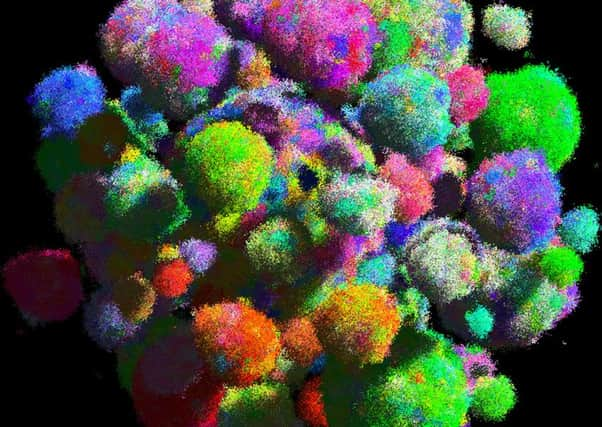3D tumour model will shed light on cancer


The computer model, built using a series of mathematical algorithms, demonstrated how even the tiniest movement of cells could rapidly transform the make-up of an entire tumour.
Researchers from Edinburgh University studied how tumours start with one rogue cell, which multiplies to become a malignant mass containing many billions of cells.
Advertisement
Hide AdAdvertisement
Hide AdThe digital model revealed that the movement and turn- over of cells in a tumour allows those cells that are the most well suited to the environment to flourish.
Any one of these can take over an existing tumour, replacing the original mass with new cells quickly – often within several months.
Lead author Dr Bartlomiej Waclaw, from Edinburgh University’s school of physics and astronomy, said: “Computer modelling of cancer enables us to gain valuable insight into how this complex disease develops over time and in three dimensions.”
“The model was based around exploring the idea that the cells in the cancerous tumours are making a number of local migrations which make the cells more and more aggressive.
“We wanted to see what kind of diversity of cells there were in the tumour and we discovered there was very little diversity at all.”
Dr Waclaw added: “In principle, by targeting some of these local migrations we could find a way to slow down the cancer by making the tumour grow more slowly.”
The mechanism does not entirely mix the cells inside the tumour, which the team believe explains why tumours are mostly made of one type of cell, whereas healthy tissue tends to comprise a mixture of cell types.
Advertisement
Hide AdAdvertisement
Hide AdParts of the tumour become immune to certain drugs, which enables them to resist chemotherapy treatment, as the cells that are not killed off by treatment can quickly flourish and repopulate the tumour as it regrows.
The models reinforce laboratory studies of how tumours evolve and spread, and why patients can respond well to therapy, only to relapse later, the study found.
The innovative research was welcomed by campaigners, who said the focus should turn now to how the technology could make useful predictions in real life.
Henry Scowcroft, senior science information manager at Cancer Research UK, said: “The idea of understanding cancer by using computers to create 3D ‘virtual’ tumours may sound like science fiction but, as this shows, it’s something researchers around the world are working on.
“But there’s a long way to go.
“The next step is to see if the way this virtual tumour grows can make useful new predictions about how cancers grow in real life.”
Mr Scowcroft added: “If it does, then it could lead to further advances in cancer research, and even more progress over the coming years.”
The study, which was published yesterday in the scientific journal Nature, was a collaboration between the University of Edinburgh and, in the US, Harvard University and Johns Hopkins University.